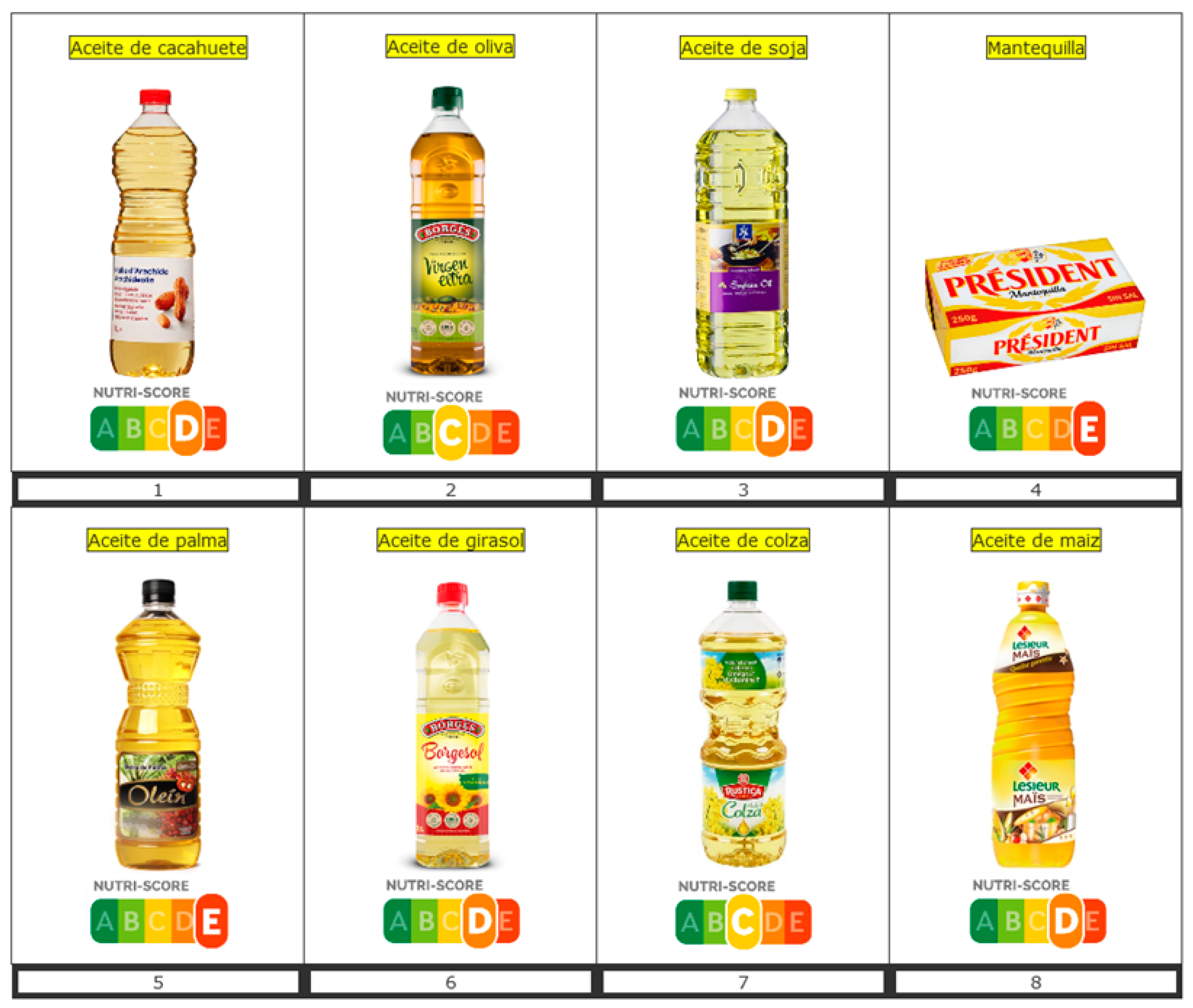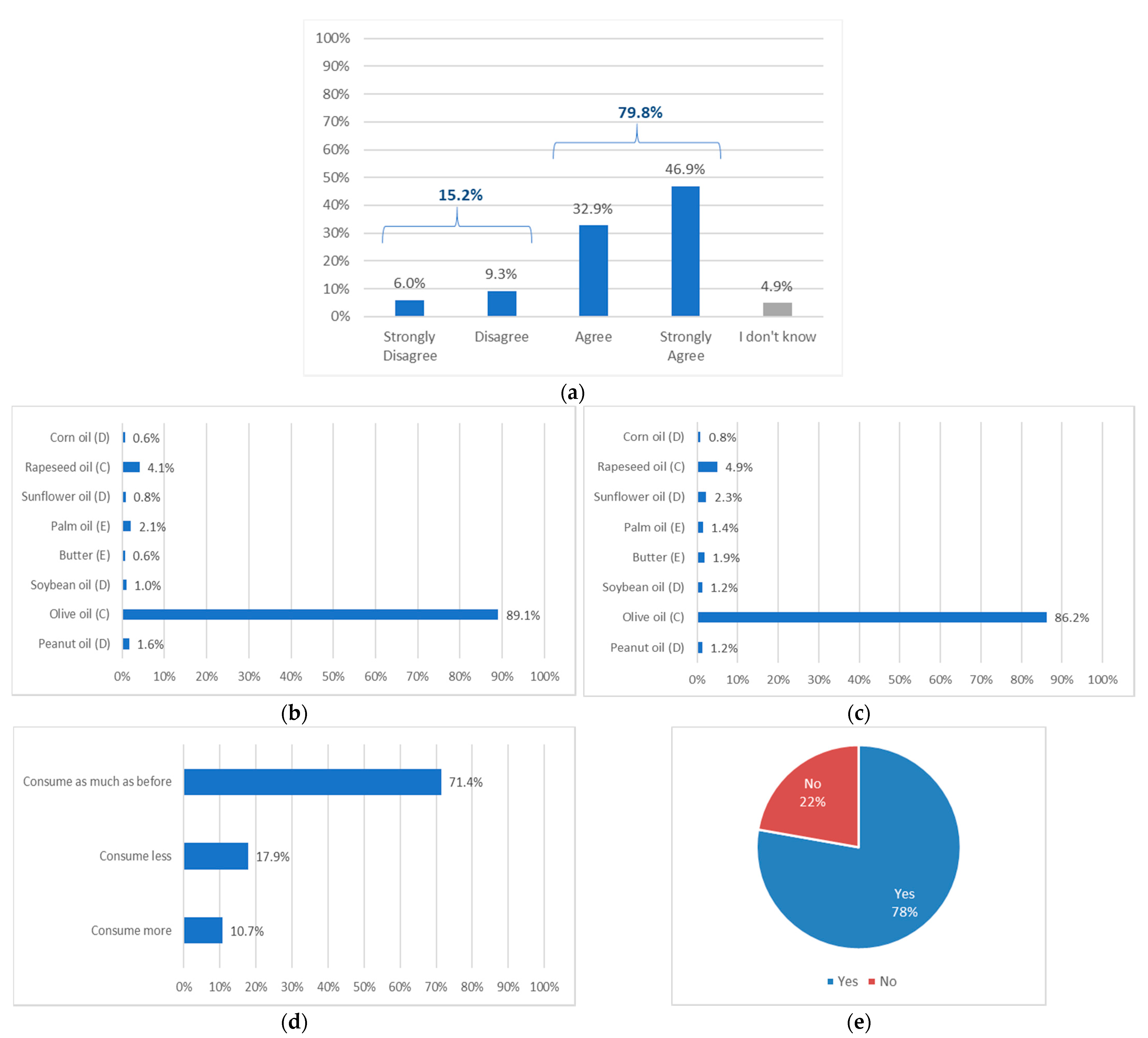Is FOP Nutrition Label Nutri-Score Well Understood by Consumers When Comparing the Nutritional Quality of Added Fats, and Does It Negatively Impact the Image of Olive Oil?
Abstract
:1. Introduction
2. Materials and Methods
2.1. Design, Population Study and Procedures
2.2. Statistical Analysis
3. Results
4. Discussion
Author Contributions
Funding
Institutional Review Board Statement
Informed Consent Statement
Data Availability Statement
Conflicts of Interest
References
- Chantal, J.; Hercberg, S.; World Health Organization. Development of a New Front-of-Pack Nutrition Label in France: The Five-Colour Nutri-Score. Public Health Panor. 2017, 3, 712–725. [Google Scholar]
- Mialon, M.; Julia, C.; Hercberg, S. The Policy Dystopia Model Adapted to the Food Industry: The Example of the Nutri-Score Saga in France. World Nutr. 2018, 9, 109–120. [Google Scholar] [CrossRef] [Green Version]
- Nutri-Score: Outil d’influence Nutritionnel, Catalyseur Des Tensions à l’échelle Européenne. Available online: http://portail-ie.fr/analysis/2687/nutri-score-outil-dinfluence-nutritionnel-catalyseur-des-tensions-a-lechelle-europeenne (accessed on 20 July 2021).
- Julia, C.; Hercberg, S. Research and Lobbying Conflicting on the Issue of a Front-of-Pack Nutrition Labelling in France. Arch. Public Health 2016, 74, 1–5. [Google Scholar] [CrossRef] [PubMed] [Green Version]
- Julia, C.; Hercberg, S. Big Food’s Opposition to the French Nutri-Score Front-of-Pack Labeling Warrants a Global Reaction. Am. J. Public Health 2018, 108, 318–320. [Google Scholar] [CrossRef] [PubMed]
- Hercberg, S.; Touvier, M.; Salas-Salvado, J.; on behalf of the Group of European Scientists Supporting the Implementation of Nutri-Sscore in Europe. The Nutri-Score Nutrition Label. Int. J. Vitam. Nutr. Res. 2021. [Google Scholar] [CrossRef] [PubMed]
- Egnell, M.; Talati, Z.; Hercberg, S.; Pettigrew, S.; Julia, C. Objective Understanding of Front-of-Package Nutrition Labels: An International Comparative Experimental Study across 12 Countries. Nutrients 2018, 10, 1542. [Google Scholar] [CrossRef] [PubMed] [Green Version]
- Egnell, M.; Talati, Z.; Galan, P.; Andreeva, V.A.; Vandevijvere, S.; Gombaud, M.; Dréano-Trécant, L.; Hercberg, S.; Pettigrew, S.; Julia, C. Objective Understanding of the Nutri-Score Front-of-Pack Label by European Consumers and Its Effect on Food Choices: An Online Experimental Study. Int. J. Behav. Nutr. Phys. Act. 2020, 17, 146. [Google Scholar] [CrossRef] [PubMed]
- Dréano-Trécant, L.; Egnell, M.; Hercberg, S.; Galan, P.; Soudon, J.; Fialon, M.; Touvier, M.; Kesse-Guyot, E.; Julia, C. Performance of the Front-of-Pack Nutrition Label Nutri-Score to Discriminate the Nutritional Quality of Foods Products: A Comparative Study across 8 European Countries. Nutrients 2020, 12, 1303. [Google Scholar] [CrossRef] [PubMed]
- Julia, C.; Ducrot, P.; Péneau, S.; Deschamps, V.; Méjean, C.; Fézeu, L.; Touvier, M.; Hercberg, S.; Kesse-Guyot, E. Discriminating Nutritional Quality of Foods Using the 5-Color Nutrition Label in the French Food Market: Consistency with Nutritional Recommendations. Nutr J 2015, 14, 100. [Google Scholar] [CrossRef] [PubMed] [Green Version]
- European Commission. A Farm to Fork Strategy: For a Fair, Healthy and Environmentally-Friendly Food System. Communication on the Commission to the European Parliament, the Council, the European Economic and Social Council and the Commitee of the Regions; European Commission: Brussels, Belgium, 2020. [Google Scholar]
- Los Sectores del Jamón Ibérico, el Queso Manchego y el Aceite de Oliva se Defienden Ante la Mala Nota de Nutri-Score. Available online: https://www.lanzadigital.com/economia/campo/los-sectores-del-jamon-iberico-el-queso-manchego-y-el-aceite-de-oliva-se-defienden-ante-la-mala-nota-de-nutri-score/ (accessed on 20 July 2021).
- Aragón, H. de Aceite, Jamón o Ternasco: Así Afectará el Semáforo NutriScore a los Productos Aragoneses. Available online: https://www.heraldo.es/noticias/aragon/2021/02/11/aceite-de-oliva-jamon-o-ternasco-asi-afectara-el-semaforo-nutriscore-a-los-productos-aragoneses-1419436.html (accessed on 20 July 2021).
- ITALY: Nutri-Score Will Damage Olive Oil Trade, Italian Producers Argue. Available online: https://www.ciheam.org/pressreview/italy-nutri-score-will-damage-olive-oil-trade-italian-producers-argue/ (accessed on 20 July 2021).
- El Sector del Aceite de Oliva se Opone al Nutri-Score Porque Confunden al Consumidor. Available online: https://www.agrodigital.com/2020/12/18/el-sector-del-aceite-de-oliva-se-opone-al-nutri-score-porque-confunden-al-consumidor/ (accessed on 20 July 2021).
- Bryła, P. Who Reads Food Labels? Selected Predictors of Consumer Interest in Front-of-Package and Back-of-Package Labels during and after the Purchase. Nutrients 2020, 12, 2605. [Google Scholar] [CrossRef] [PubMed]
- Guasch-Ferré, M.; Hu, F.B.; Martínez-González, M.A.; Fitó, M.; Bulló, M.; Estruch, R.; Ros, E.; Corella, D.; Recondo, J.; Gómez-Gracia, E. Olive Oil Intake and Risk of Cardiovascular Disease and Mortality in the PREDIMED Study. BMC Med. 2014, 12, 1–11. [Google Scholar] [CrossRef] [PubMed] [Green Version]
- George, E.S.; Marshall, S.; Mayr, H.L.; Trakman, G.L.; Tatucu-Babet, O.A.; Lassemillante, A.-C.M.; Bramley, A.; Reddy, A.J.; Forsyth, A.; Tierney, A.C.; et al. The Effect of High-Polyphenol Extra Virgin Olive Oil on Cardiovascular Risk Factors: A Systematic Review and Meta-Analysis. Crit. Rev. Food Sci. Nutr. 2019, 59, 2772–2795. [Google Scholar] [CrossRef] [PubMed]
- Fernandes, J.; Fialho, M.; Santos, R.; Peixoto-Placido, C.; Madeira, T.; Sousa-Santos, N.; Virgolino, A.; Santos, O.; Carneiro, A.V. Is Olive Oil Good for You? A Systematic Review and Meta-Analysis on Anti-Inflammatory Benefits from Regular Dietary Intake. Nutrition 2020, 69, 110559. [Google Scholar] [CrossRef] [PubMed]
- Amiri, M.; Raeisi-Dehkordi, H.; Sarrafzadegan, N.; Forbes, S.C.; Salehi-Abargouei, A. The Effects of Canola Oil on Cardiovascular Risk Factors: A Systematic Review and Meta-Analysis with Dose-Response Analysis of Controlled Clinical Trials. Nutr. Metab. Cardiovasc. Dis. 2020, 30, 2133–2145. [Google Scholar] [CrossRef] [PubMed]
- Kris-Etherton, P.M. Walnuts Decrease Risk of Cardiovascular Disease: A Summary of Efficacy and Biologic Mechanisms. J. Nutr. 2014, 144, 547S–554S. [Google Scholar] [CrossRef] [PubMed] [Green Version]
- Ghobadi, S.; Hassanzadeh-Rostami, Z.; Mohammadian, F.; Zare, M.; Faghih, S. Effects of Canola Oil Consumption on Lipid Profile: A Systematic Review and Meta-Analysis of Randomized Controlled Clinical Trials. J. Am. Coll. Nutr. 2019, 38, 185–196. [Google Scholar] [CrossRef] [PubMed]
- CONSUMER Datos: Este ha Sido el Efecto de Nutri-Score en las Ventas de EROSKI. Available online: https://www.consumer.es/alimentacion/datos-nutri-score-efecto-ventas.html (accessed on 20 July 2021).
- Yubero-Serrano, E.M.; Lopez-Moreno, J.; Gomez-Delgado, F.; Lopez-Miranda, J. Extra Virgin Olive Oil: More than a Healthy Fat. Eur. J. Clin. Nutr. 2019, 72, 8–17. [Google Scholar] [CrossRef] [PubMed] [Green Version]
- Katsiki, N.; Pérez-Martínez, P.; Lopez-Miranda, J. Olive Oil Intake and Cardiovascular Disease Prevention:“Seek and You Shall Find”. Curr. Cardiol. Rep. 2021, 23, 1–5. [Google Scholar] [CrossRef] [PubMed]


| N (%) | |
|---|---|
| Sex | |
| Men | 250 (51.4) |
| Women | 236 (48.6) |
| Age, years | |
| 18–34 | 115 (23.7) |
| 35–54 | 213 (43.8) |
| 55–80 | 158 (32.5) |
| Educational level | |
| Primary education | 13 (2.7) |
| Secondary education | 42 (8.6) |
| Trade certificate 1 | 246 (50.6) |
| University undergraduate degree | 139 (28.6) |
| University postgraduate degree | 46 (9.5) |
| Number of persons in household | |
| Total | mean = 2.91 (SD = 1.19) Range: 1 to 9 |
| Number of persons ≤ 13 years | mean = 0.44 (SD = 0.70) Range: 0 to 4 |
| Self-estimated diet quality | |
| I eat a very unhealthy diet | 1 (0.2) |
| I eat a mostly unhealthy diet | 65 (13.4) |
| I eat a mostly healthy diet | 371 (76.3) |
| I eat a very healthy diet | 49 (10.1) |
| Self-estimated nutrition knowledge | |
| I do not know anything about nutrition | 27 (5.6) |
| I am not very knowledgeable about nutrition | 257 (52.9) |
| I am somewhat knowledgeable about nutrition | 187 (38.5) |
| I am very knowledgeable about nutrition | 15 (3.1) |
| N = 462 (Participants Who Responded « I Don’t Know » (N = 24) Were Excluded from the Analysis) | ||
|---|---|---|
| Variables | OR (95% CI) | p-Value |
| Age (continuous) | 1.02 (1.00–1.04) | 0.03 |
| Sex | ||
| Male | Ref | |
| Female | 1.31 (0.79–2.20) | 0.30 |
| Education | ||
| Trade certificate or lower1 | Ref | |
| University degree | 0.62 (0.37–1.05) | 0.08 |
| Has Children | ||
| No | Ref | |
| Yes | 2.15 (1.19–4.03) | 0.01 |
| Self-perceived diet quality | ||
| Poor diet quality | Ref | |
| Good diet quality | 0.74 (0.30–1.60) | 0.47 |
| Self-rated nutritional knowledge | ||
| Little knowledge of nutrition | Ref | |
| Good knowledge of nutrition | 0.73 (0.43–1.24) | 0.24 |
| N = 486 | ||
|---|---|---|
| Variables | OR (95% CI) | p-Value |
| Age (continuous) | 1.01 (0.99–1.02) | 0.54 |
| Sex | ||
| Male | Ref | |
| Female | 0.71 (0.46–1.11) | 0.13 |
| Education | ||
| Trade certificate or lower1 | Ref | |
| University degree | 0.69 (0.44–1.09) | 0.11 |
| Has Children | ||
| No | Ref | |
| Yes | 1.82 (1.10–3.10) | 0.02 |
| Self-perceived diet quality | ||
| Poor diet quality | Ref | |
| Good diet quality | 0.66 (0.30–1.34) | 0.27 |
| Self-rated nutritional knowledge | ||
| Little knowledge of nutrition | Ref | |
| Good knowledge of nutrition | 0.65 (0.41–1.03) | 0.07 |
Publisher’s Note: MDPI stays neutral with regard to jurisdictional claims in published maps and institutional affiliations. |
© 2021 by the authors. Licensee MDPI, Basel, Switzerland. This article is an open access article distributed under the terms and conditions of the Creative Commons Attribution (CC BY) license (https://creativecommons.org/licenses/by/4.0/).
Share and Cite
Fialon, M.; Salas-Salvadó, J.; Babio, N.; Touvier, M.; Hercberg, S.; Galan, P. Is FOP Nutrition Label Nutri-Score Well Understood by Consumers When Comparing the Nutritional Quality of Added Fats, and Does It Negatively Impact the Image of Olive Oil? Foods 2021, 10, 2209. https://doi.org/10.3390/foods10092209
Fialon M, Salas-Salvadó J, Babio N, Touvier M, Hercberg S, Galan P. Is FOP Nutrition Label Nutri-Score Well Understood by Consumers When Comparing the Nutritional Quality of Added Fats, and Does It Negatively Impact the Image of Olive Oil? Foods. 2021; 10(9):2209. https://doi.org/10.3390/foods10092209
Chicago/Turabian StyleFialon, Morgane, Jordi Salas-Salvadó, Nancy Babio, Mathilde Touvier, Serge Hercberg, and Pilar Galan. 2021. "Is FOP Nutrition Label Nutri-Score Well Understood by Consumers When Comparing the Nutritional Quality of Added Fats, and Does It Negatively Impact the Image of Olive Oil?" Foods 10, no. 9: 2209. https://doi.org/10.3390/foods10092209
APA StyleFialon, M., Salas-Salvadó, J., Babio, N., Touvier, M., Hercberg, S., & Galan, P. (2021). Is FOP Nutrition Label Nutri-Score Well Understood by Consumers When Comparing the Nutritional Quality of Added Fats, and Does It Negatively Impact the Image of Olive Oil? Foods, 10(9), 2209. https://doi.org/10.3390/foods10092209







